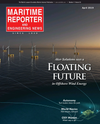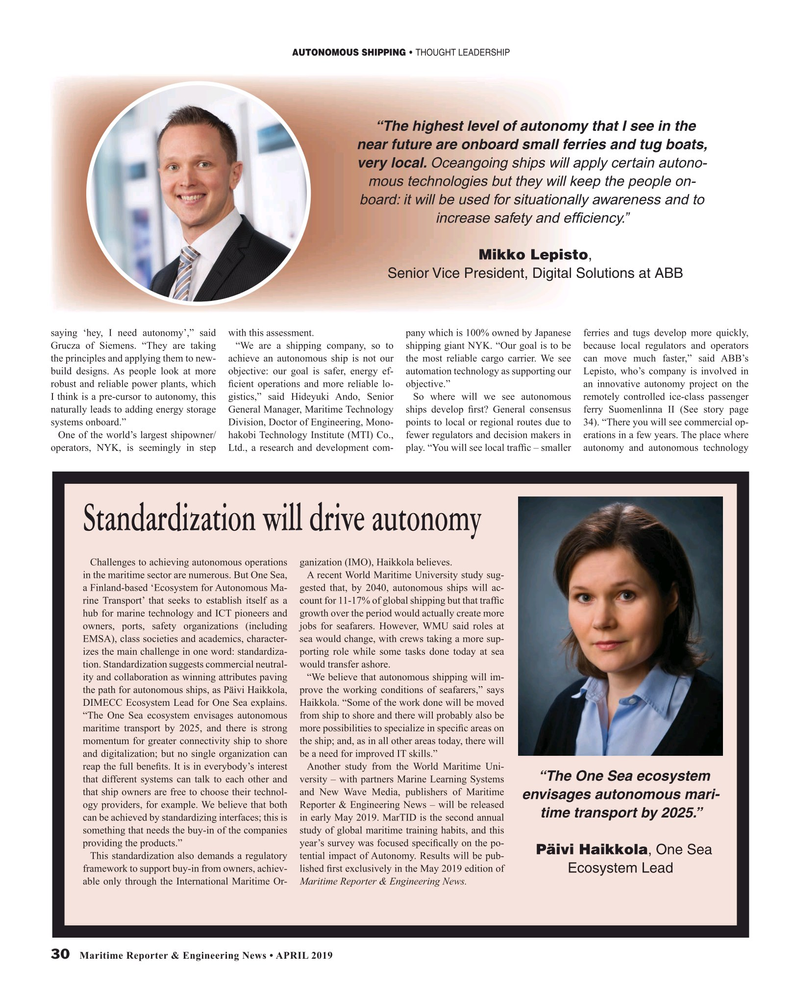
Page 30: of Maritime Reporter Magazine (April 2019)
Navies of the World
Read this page in Pdf, Flash or Html5 edition of April 2019 Maritime Reporter Magazine
AUTONOMOUS SHIPPING • THOUGHT LEADERSHIP “The highest level of autonomy that I see in the near future are onboard small ferries and tug boats, very local. Oceangoing ships will apply certain autono- mous technologies but they will keep the people on- board: it will be used for situationally awareness and to increase safety and ef? ciency.”
Mikko Lepisto,
Senior Vice President, Digital Solutions at ABB saying ‘hey, I need autonomy’,” said with this assessment. pany which is 100% owned by Japanese ferries and tugs develop more quickly,
Grucza of Siemens. “They are taking “We are a shipping company, so to shipping giant NYK. “Our goal is to be because local regulators and operators the principles and applying them to new- achieve an autonomous ship is not our the most reliable cargo carrier. We see can move much faster,” said ABB’s build designs. As people look at more objective: our goal is safer, energy ef- automation technology as supporting our Lepisto, who’s company is involved in robust and reliable power plants, which ? cient operations and more reliable lo- objective.” an innovative autonomy project on the
I think is a pre-cursor to autonomy, this gistics,” said Hideyuki Ando, Senior So where will we see autonomous remotely controlled ice-class passenger naturally leads to adding energy storage General Manager, Maritime Technology ships develop ? rst? General consensus ferry Suomenlinna II (See story page systems onboard.” Division, Doctor of Engineering, Mono- points to local or regional routes due to 34). “There you will see commercial op-
One of the world’s largest shipowner/ hakobi Technology Institute (MTI) Co., fewer regulators and decision makers in erations in a few years. The place where operators, NYK, is seemingly in step Ltd., a research and development com- play. “You will see local traf? c – smaller autonomy and autonomous technology
Standardization will drive autonomy
Challenges to achieving autonomous operations ganization (IMO), Haikkola believes.
in the maritime sector are numerous. But One Sea, A recent World Maritime University study sug- a Finland-based ‘Ecosystem for Autonomous Ma- gested that, by 2040, autonomous ships will ac- rine Transport’ that seeks to establish itself as a count for 11-17% of global shipping but that traf? c hub for marine technology and ICT pioneers and growth over the period would actually create more owners, ports, safety organizations (including jobs for seafarers. However, WMU said roles at
EMSA), class societies and academics, character- sea would change, with crews taking a more sup- izes the main challenge in one word: standardiza- porting role while some tasks done today at sea tion. Standardization suggests commercial neutral- would transfer ashore. ity and collaboration as winning attributes paving “We believe that autonomous shipping will im- the path for autonomous ships, as Päivi Haikkola, prove the working conditions of seafarers,” says
DIMECC Ecosystem Lead for One Sea explains. Haikkola. “Some of the work done will be moved “The One Sea ecosystem envisages autonomous from ship to shore and there will probably also be maritime transport by 2025, and there is strong more possibilities to specialize in speci? c areas on momentum for greater connectivity ship to shore the ship; and, as in all other areas today, there will and digitalization; but no single organization can be a need for improved IT skills.” reap the full bene? ts. It is in everybody’s interest Another study from the World Maritime Uni- “The One Sea ecosystem that different systems can talk to each other and versity – with partners Marine Learning Systems that ship owners are free to choose their technol- and New Wave Media, publishers of Maritime envisages autonomous mari- ogy providers, for example. We believe that both Reporter & Engineering News – will be released time transport by 2025.” can be achieved by standardizing interfaces; this is in early May 2019. MarTID is the second annual something that needs the buy-in of the companies study of global maritime training habits, and this providing the products.” year’s survey was focused speci? cally on the po-
Päivi Haikkola, One Sea
This standardization also demands a regulatory tential impact of Autonomy. Results will be pub- framework to support buy-in from owners, achiev- lished ? rst exclusively in the May 2019 edition of
Ecosystem Lead able only through the International Maritime Or- Maritime Reporter & Engineering News.
30 Maritime Reporter & Engineering News • APRIL 2019
MR #4 (26-33).indd 30 4/2/2019 12:21:38 PM

 29
29

 31
31
